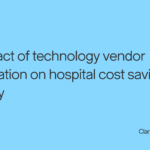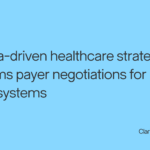The Quadruple Aim in healthcare is a framework that expands upon the traditional Triple Aim (improving population health, enhancing patient experience, and reducing per capita costs) by adding a fourth dimension: improving the well-being and job satisfaction of healthcare providers and staff. Bundled payments were introduced to the U.S. healthcare system in the early 2000s. These payments refer to a single, fixed payment to cover all the services and treatments related to a specific medical episode or condition. This approach encourages healthcare providers to collaborate and deliver cost-effective, high-quality care, as they are financially responsible for the entire episode of care. Now that bundled payments have been a part of the healthcare system for well over a decade, stakeholders are assessing whether or not these payment models successfully met the objectives of the Quadruple Aim. Population health refers to the overall health outcomes and well-being of a specific group, often within a geographic area or defined demographic. It encompasses a holistic approach to healthcare that considers not only individual health but also the broader social, economic, and environmental factors that influence health. This approach seeks to improve the health of the entire community through preventive measures, healthcare interventions, and health promotion strategies. Bundled payments have the potential to positively impact population health by incentivizing providers to deliver more efficient, personalized, and coordinated care. Yet, to date, bundled payments have yielded mixed outcomes in their effect on population health. While bundles show promise in reducing costs and enhancing the coordination of care, their impact on the overall population is difficult to measure. Here are a few examples of how bundled payments, if widely adopted, can improve population health: 1. Care Coordination: Bundled payments can encourage better coordination among healthcare providers involved in a patient’s care. When multiple providers collaborate efficiently, it can lead to better patient outcomes, reduced duplication of services, and improved population health. 2. Incentives for Efficiency: Providers under bundled payment arrangements have financial incentives to deliver care more efficiently without compromising quality. This can lead to reduced healthcare costs, which, in turn, can make healthcare more accessible and affordable for the population. 3. Focus on Prevention and Wellness: Some bundled payment models encourage providers to emphasize preventive care and wellness because keeping patients healthy can reduce the need for costly acute care services. This can have a positive impact on the overall health of the population. 4. Reduced Fragmentation: Bundled payments may reduce the fragmentation of care, which can be a barrier to good health outcomes. When care is coordinated and integrated, patients are more likely to receive appropriate care and follow treatment plans. 5. Data and Analytics: Bundled payment programs often rely on data and analytics to track and measure outcomes. This can lead to better insights into healthcare trends and population health needs, which can inform public health strategies. However, it’s essential to consider potential challenges and limitations: 1. Risk Selection: There is a risk that providers may avoid high-risk or complex patients under bundled payment models, which could lead to health disparities in the population. 2. Limited Scope: The impact of bundled payments may be limited to specific episodes of care, and they may not address broader determinants of population health, such as social and economic factors. 3. Variability in Implementation: The success of bundled payments depends on how they are designed and implemented. Variability in design and execution can lead to varying outcomes. 4. Data and Measurement Challenges: Accurately measuring the impact of bundled payments on population health can be challenging due to data limitations and the need for long-term evaluation. 5. Adoption: Despite their promise, bundled payments have not been widely adopted across the industry, lessening their impact on population health. In summary, bundled payments have the potential to positively impact population health by promoting care coordination, efficiency, prevention, and data-driven decision-making. However, their success in achieving this goal depends on various factors, including the specific design of the bundled payment program and the broader healthcare ecosystem in which it operates. Further research and evaluation are necessary to fully understand their impact on population health. The patient experience signifies a person’s overall encounter with the healthcare system, including interactions with providers, the quality of care received, and the emotional and practical aspects of their journey. To ensure a positive patient experience, healthcare professionals must communicate clearly, show empathy, and demonstrate respect. A good patient experience also requires providers to ensure patients can access care easily, receive effective treatments, and don’t have to deal with extensive wait times. A positive patient experience is essential for fostering trust and satisfaction among patients and improving health outcomes, as it can enhance adherence to treatment plans and overall well-being. Bundled payments were designed to enhance the patient experience by encouraging providers to coordinate care more efficiently, reducing service fragmentation, and improving provider communication. This streamlined approach aims to make the healthcare journey smoother for patients, ensuring that their needs are met more comprehensively and with a focus on delivering value-based care. While bundled payments certainly seek to improve the patient experience, their overall impact on the patient experience has been inconsistent. Variability in patient experiences with bundled payments often arises from differences in how providers implement these models — highlighting the importance of effective execution and ongoing monitoring to ensure that the patient experience is consistently improved. Here are some ways in which bundled payments can influence the patient experience: 1. Care Coordination: Bundled payments can encourage better coordination among healthcare providers involved in a patient’s care. When multiple providers work together effectively, it can lead to a smoother and more seamless healthcare experience for the patient. Patients may experience fewer communication breakdowns and transitions between providers, resulting in a more positive overall experience. 2. Quality Improvement: In bundled payment models, providers often have financial incentives tied to quality metrics and patient outcomes. This can lead to a greater focus on delivering high-quality care, which can positively impact the patient’s experience by reducing complications, readmissions, and adverse events. 3. Patient-Centered Care: Bundled payment programs may emphasize patient-centered care, where the patient’s preferences and needs are taken into account in treatment decisions. When patients feel heard and respected, their overall experience is likely to improve. 4. Cost Transparency: Some bundled payment models provide patients with more transparency regarding the cost of their care. Patients may appreciate knowing the total cost of an episode of care upfront, which can help them make informed decisions and reduce financial stress. However, it’s essential to consider potential challenges and limitations that may affect the patient experience: 1. Limited Choice: In some bundled payment programs, patients may have limited choice in selecting providers, as the program may dictate which providers are included in the bundle. This lack of choice can be frustrating for patients who prefer specific providers. 2. Risk Selection: Providers may be incentivized to avoid high-risk or complex patients under bundled payment models, potentially leading to disparities in care quality and patient experiences. 3. Impact on Access: Depending on the design of the bundled payment program, it could impact patient access to care, especially if certain providers or services are excluded from the bundle. Reduced access to preferred providers or services may negatively affect the patient experience. 4. Billing Complexity: Patients may find the billing process more complex under bundled payment models, as they receive a single bill for multiple services. This can lead to confusion and dissatisfaction if not managed well. In summary, bundled payments can have both positive and negative effects on the patient experience. When implemented effectively with a focus on care coordination, quality improvement, and patient-centered care, bundled payments have the potential to enhance the patient experience. However, challenges such as limited choice and risk selection must be carefully addressed to ensure that patients receive high-quality, patient-centered care that meets their needs and preferences. Healthcare costs have been a growing concern, and bundled payments represent a financial model aimed at addressing this issue. By receiving a fixed payment for an entire episode of care, providers have a financial incentive to avoid unnecessary tests, treatments, and hospital readmissions. Theoretically, this approach would reduce healthcare expenditures while maintaining or improving patient outcomes. In reality, bundled payments have only partially reduced healthcare costs. The success of bundled payments often depends on the specific design and implementation of the payment model, which can vary widely across healthcare organizations. Additionally, achieving cost savings through bundled payments may take time, and short-term results may not always reflect their full potential. Addressing broader systemic issues — such as the widespread variation in healthcare prices, pharmaceutical costs, and socioeconomic determinants of health — is essential to realize the long-term cost-reduction goals of bundled payment programs. Care team well-being is a vital component of healthcare’s Quadruple Aim because it directly impacts the quality of patient care and the overall performance of the U.S. healthcare system. When healthcare professionals, including physicians, nurses, and support staff, experience high levels of well-being, they are more engaged, motivated, and better equipped to provide quality care. This results in improved patient outcomes and satisfaction. Additionally, a well-supported care team is less likely to experience burnout or turnover, contributing to the overall sustainability and effectiveness of the healthcare system. Bundled payments were theorized to improve care team well-being by fostering greater collaboration and reducing administrative burdens on providers. The model encourages care teams to work together more cohesively, enhancing job satisfaction and decreasing the stress associated with fragmented care delivery. Additionally, the streamlined reimbursement process under bundled payments can lead to fewer administrative hassles, allowing care team members to focus more on patient care, further contributing to their overall well-being. So far, bundled payments have yet to be very successful in improving care teams’ well-being. While the model was created to encourage more efficient and coordinated care, in practice, the administrative and logistical challenges of managing bundled payments frequently fall on care teams. Moreover, the financial benefits of bundled payments often accrue more to health systems than individual care team members, creating a misalignment of incentives. Furthermore, the pressure to keep costs under the bundled payment amount can sometimes lead to decreased resources, putting additional strain on care teams. These factors can contribute to caregiver burnout and hinder the intended improvement in care team well-being. Bundled payments have the potential to contribute positively to the Quadruple Aim by improving population health, enhancing patient experience, reducing per capita costs, and improving provider well-being when implemented effectively. However, their impact can vary, and addressing challenges and ensuring appropriate program design is crucial to maximizing their benefits. Evaluation and adaptation of bundled payment programs are ongoing processes to achieve the Quadruple Aim effectively. As we assess the impact of bundled payments and other value-based care models, we must recognize that healthcare is multifaceted, and success cannot be solely attributed to payment models. Encouraging physicians to prioritize other incentives, such as addressing social determinants of health and promoting well-being within care teams, is essential for building a healthcare system that truly meets the needs of patients and providers alike.Did bundled payments improve population health?
Did bundled payments enhance the patient experience?
Did bundled payments reduce costs?
Did bundled payments improve care team well-being?
Conclusion
- Author Details





